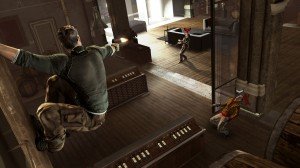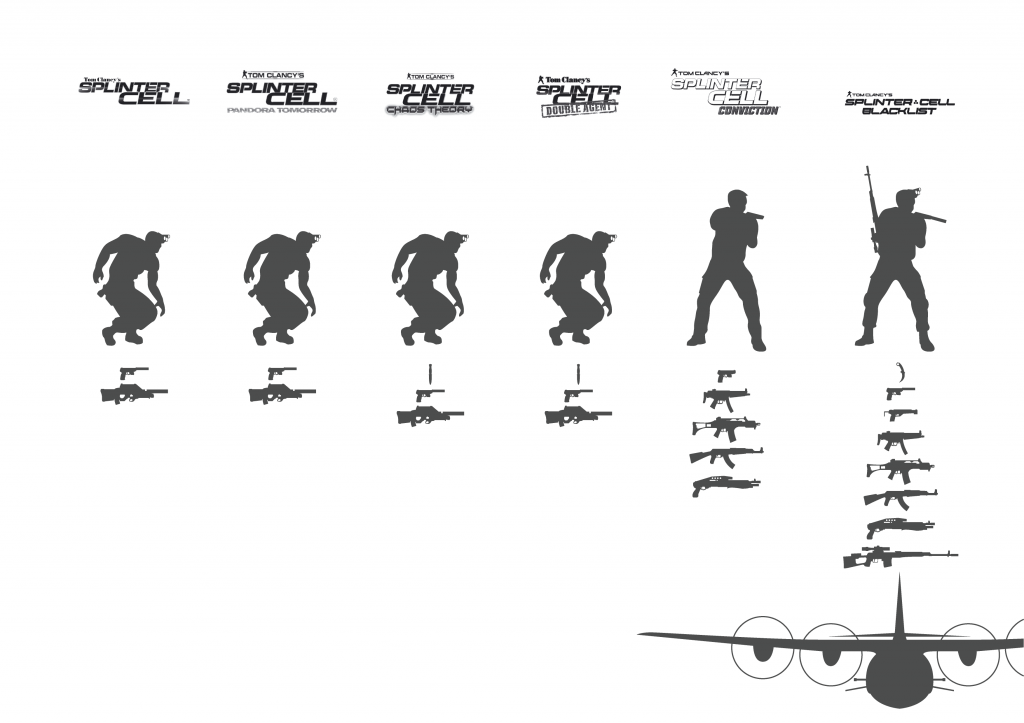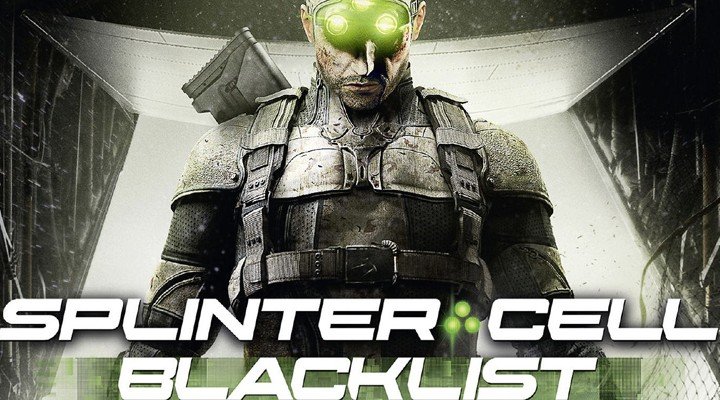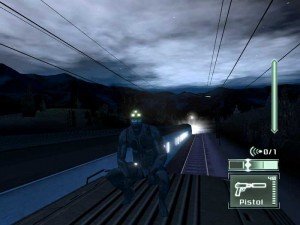*Squeeeee* Hopefully you read that as Splinter Cell’s iconic ‘goggle noise’, a sound almost as instantly recognizable as rival series Metal Gear’s ‘FRING’ alert soundbite.
The franchise rocketed to success in 2002 by taking the most combat-lite sections of MGS and refining them through the overall tonality of a real-world setting, placing the player in the rubberized shoes of Sam Fisher, a gruff-voiced, neck-snapping professional badass thrust into a world of terrorist threats and espionage. Whereas Metal Gear always had a blockbuster heart underpinning its louder moments, Splinter Cell had (until recent installments) always remained the quieter of the two, developing a dedicated fanbase along the way.
SC was that scene in Mission Impossible where Tom Cruise precariously dangles from a ventilation shaft, hacking a computer surrounded by lasers and sensors, whereas MGS is that same character leaping out of a skyscraper in the sequel. Both scenes are undeniably cool, but for those of us who always wanted to be the type of gadget-equipped superspy that infiltrates, executes, and disappears without a trace, Splinter Cell was our game.
With 6 games under Ubisoft’s belt, each subsequent release constructs a juggernaut hype machine, and with the series’ third installment Chaos Theory being widely regarded as its best back in 2005, the legendary French developer has struggled to reclaim those lofty heights ever since.
CT took the questionable up-close combat of the previous games and introduced a double-trigger system of lethal and non-lethal takedowns, allowing for encounters to have just the right amount of powerplay between NPC’s and the player. They may have guns, and there may be four times as many of them than you, but when you can dart between the shadows setting off distractions to lure patrols apart only to dispatch them in a blur of blades and knockout punches, Chaos Theory was perfect.
However, 2010’s Splinter Cell: Conviction ditched these mechanics, giving the series its most noticeable shakeup in gameplay by injecting a total animation overhaul alongside a ‘mark and execute’ mechanic that allowed you to target groups of guards and eliminate them instantly.
Badass? Certainly, but with a franchise predicated on carefully executed infiltration tactics and guard-baiting patrol patterns, it was a move that divided the fervent fanbase the series had built up. Whilst you could hang back, scout your environment, and people-watch as per the Cell norm, there was a very pertinent sense of ‘get up and go’ that permeated Conviction due to its introduction of a more driven narrative. As well as making the aging Fisher move much faster than he had in previous games, the most noticeable absence was the iconic triple-light goggles that every fan had come to know and love. Whilst Sam would reacquire them later in the story, coupling this lack of traditional gadgetry with the overall new direction the series seemed to be going in left fans feeling sour.
Introducing interrogation sequences that were glorified cutscenes was an attempt to give weight to Sam’s motivations, and although the story told was a very personal one, as the series was never one that revolved around a narrative to get players involved, it ultimately fell flat. Although the mechanics were solid, fans still clamored for a return to the contemplative style of old. Many remember the CIA level from the first game, or the mind-blowing sequence aboard a moving train in the second installment Pandora Tomorrow, yet for all the bolstering-on of action-heavy mechanics and set-pieces in Conviction, few of them hit home.

The Mark and Execute technique sped up gameplay considerably, but was that a good thing for the series?
Enter Blacklist.
With the newest edition of the game, Ubisoft is trying to satisfy both sides of the fan spectrum, offering gameplay that identifies the more traditional Cell experience whilst retaining all the effort they put into Conviction to spruce up the game mechanics for your more average player. They’re calling the styles Ghost, Assault, and Panther, the former being the invisible ‘who turned out the lights?!’ approach, and the latter two featuring all out warfare, or a blend of the two.
Chaos Theory featured a watered-down version of this, allowing you to choose different loadouts at the start of a mission under the labels of ‘Stealth’ or ‘Assault’, yet you’d still be hard-pressed to find anyone who tackled that games’ missions with the shotgun as oppose to the trusty SC-20K multi-purpose sniper/assault rifle. However, all this seeming return-to-form is slightly offset by the developers ditching longtime Fisher voice-actor Michael ‘Throat-full-o’razors’ Ironside, instead going with the younger actor Eric Johnson. Why they couldn’t have retained Ironside as Fisher on the other end of a comms link advising a rookie Cell agent into the fold we’ll never know. Instead, Ubisoft balanced their initial goodwill by mimicking Metal Gear’s replacement of David Hayter with Keifer Sutherland for the sake of more emotive cutscenes, calling for further questioning into how far across the Hollywood blockbuster line they were again attempting to cross.

A slightly humorous look at the evolution of Sam Fisher’s arsenal across the 6 main games in the franchise.
Only time will tell if this potentially potent mix of the most well-received past ingredients will actually prove to be the series’ saving grace, but for now, all we can do is gather up our resources and wait until the end of the month.
Oh, and the best thing? The goggles are back in full force!
Splinter Cell: Blacklist will be released on August 20th (NA), 23rd (EU) and the 5th of September (JP).



